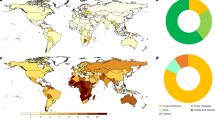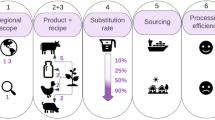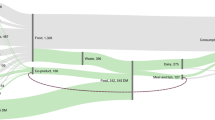Abstract
Ruminant meat provides valuable protein to humans, but livestock production has many negative environmental impacts, especially in terms of deforestation, greenhouse gas emissions, water use and eutrophication1. In addition to a dietary shift towards plant-based diets2, imitation products, including plant-based meat, cultured meat and fermentation-derived microbial protein (MP), have been proposed as means to reduce the externalities of livestock production3,4,5,6,7. Life cycle assessment (LCA) studies have estimated substantial environmental benefits of MP, produced in bioreactors using sugar as feedstock, especially compared to ruminant meat3,7. Here we present an analysis of MP as substitute for ruminant meat in forward-looking global land-use scenarios towards 2050. Our study complements LCA studies by estimating the environmental benefits of MP within a future socio-economic pathway. Our model projections show that substituting 20% of per-capita ruminant meat consumption with MP globally by 2050 (on a protein basis) offsets future increases in global pasture area, cutting annual deforestation and related CO2 emissions roughly in half, while also lowering methane emissions. However, further upscaling of MP, under the assumption of given consumer acceptance, results in a non-linear saturation effect on reduced deforestation and related CO2 emissions—an effect that cannot be captured with the method of static LCA.
This is a preview of subscription content, access via your institution
Access options
Access Nature and 54 other Nature Portfolio journals
Get Nature+, our best-value online-access subscription
$29.99 / 30 days
cancel any time
Subscribe to this journal
Receive 51 print issues and online access
$199.00 per year
only $3.90 per issue
Buy this article
- Purchase on Springer Link
- Instant access to full article PDF
Prices may be subject to local taxes which are calculated during checkout



Similar content being viewed by others
Data availability
The numerical scenario results, including instructions for reproduction and the analysis scripts supporting the findings of this study are available at Zenodo https://doi.org/10.5281/zenodo.5794460 under a CC-BY-4.0 licence. Source data are provided with this paper.
Code availability
The source code for MAgPIE v.4.3.4 is publicly available at https://github.com/magpiemodel and Zenodo https://doi.org/10.5281/zenodo.4730378. The model documentation is available at https://rse.pik-potsdam.de/doc/magpie/4.3.4/.
References
Poore, J. & Nemecek, T. Reducing food’s environmental impacts through producers and consumers. Science 360, 987–992 (2018).
Soergel, B. et al. A sustainable development pathway for climate action within the UN 2030 Agenda. Nat. Clim. Change 11, 656–664 (2021).
Hashempour-Baltork, F., Khosravi-Darani, K., Hosseini, H., Farshi, P. & Reihani, S. F. S. Mycoproteins as safe meat substitutes. J. Clean. Prod. 253, 119958 (2020).
Finnigan, T. J. A. et al. Mycoprotein: the future of nutritious nonmeat protein, a symposium review. Curr. Dev. Nutr. 3, nzz021 (2019).
Stephens, N. et al. Bringing cultured meat to market: technical, socio-political, and regulatory challenges in cellular agriculture. Trends Food Sci. Technol. 78, 155–166 (2018).
Linder, T. Making the case for edible microorganisms as an integral part of a more sustainable and resilient food production system. Food Secur. 11, 265–278 (2019).
Rubio, N. R., Xiang, N. & Kaplan, D. L. Plant-based and cell-based approaches to meat production. Nat. Commun. 11, 6276 (2020).
Food and Agriculture Organization of the United Nations. Food and agricultural data. FAOSTAT https://www.fao.org/faostat (accessed 26 March 2021).
Herrero, M. et al. Greenhouse gas mitigation potentials in the livestock sector. Nat. Clim. Change 6, 452–461 (2016).
Crippa, M. et al. Food systems are responsible for a third of global anthropogenic GHG emissions. Nat. Food 2, 198–209 (2021).
Steinfeld, H. & Gerber, P. Livestock production and the global environment: consume less or produce better? Proc. Natl Acad. Sci. USA 107, 18237–18238 (2010).
Weindl, I. et al. Livestock and human use of land: productivity trends and dietary choices as drivers of future land and carbon dynamics. Glob. Planet. Change 159, 1–10 (2017).
Heinke, J. et al. Water use in global livestock production—opportunities and constraints for increasing water productivity. Water Resour. Res. 56, e2019WR026995 (2020).
Godfray, H. C. J. et al. Food security: the challenge of feeding 9 billion people. Science 327, 812–818 (2010).
Popp, A. et al. Land-use futures in the shared socio-economic pathways. Glob. Environ. Change 42, 331–345 (2017).
Willett, W. et al. Food in the Anthropocene: the EAT–Lancet Commission on healthy diets from sustainable food systems. Lancet 393, 447–492 (2019).
Sun, Z. et al. Dietary change in high-income nations alone can lead to substantial double climate dividend. Nat. Food 3, 29–37 (2022).
Fehér, A., Gazdecki, M., Véha, M., Szakály, M. & Szakály, Z. A comprehensive review of the benefits of and the barriers to the switch to a plant-based diet. Sustainability 12, 4136 (2020).
Herrero, M. et al. Innovation can accelerate the transition towards a sustainable food system. Nat. Food 1, 266–272 (2020).
Stephens, N. & Ellis, M. Cellular agriculture in the UK: a review. Wellcome Open Res. 5, 12 (2020).
Ciani, M. et al. Microbes: food for the future. Foods 10, 971 (2021).
Sillman, J. et al. A life cycle environmental sustainability analysis of microbial protein production via power-to-food approaches. Int. J. Life Cycle Assess. 25, 2190–2203 (2020).
Järviö, N., Maljanen, N.-L., Kobayashi, Y., Ryynänen, T. & Tuomisto, H. L. An attributional life cycle assessment of microbial protein production: a case study on using hydrogen-oxidizing bacteria. Sci. Total Environ. 776, 145764 (2021).
Edwards, D. G. & Cummings, J. H. The protein quality of mycoprotein. Proc. Nutr. Soc. 69, E331 (2010).
Souza Filho, P. F., Andersson, D., Ferreira, J. A. & Taherzadeh, M. J. Mycoprotein: environmental impact and health aspects. World J. Microbiol. Biotechnol. 35, 147 (2019).
Smetana, S., Mathys, A., Knoch, A. & Heinz, V. Meat alternatives: life cycle assessment of most known meat substitutes. Int. J. Life Cycle Assess. 20, 1254–1267 (2015).
Alexander, P. et al. Could consumption of insects, cultured meat or imitation meat reduce global agricultural land use? Glob. Food Sec. 15, 22–32 (2017).
Pikaar, I. et al. Decoupling livestock from land use through industrial feed production pathways. Environ. Sci. Technol. 52, 7351–7359 (2018).
Lapeña, D. et al. Production and characterization of yeasts grown on media composed of spruce-derived sugars and protein hydrolysates from chicken by-products. Microb. Cell Fact. 19, 19 (2020).
Dietrich, J. P. et al. MAgPIE 4 - a modular open-source framework for modeling global land systems. Geosci. Model Dev. 12, 1299–1317 (2019).
Dietrich, J. P. et al. MAgPIE - An Open Source Land-Use Modeling Framework, v.4.3.4. Zenodo https://doi.org/10.5281/zenodo.4730378 (2021).
Jägermeyr, J., Pastor, A., Biemans, H. & Gerten, D. Reconciling irrigated food production with environmental flows for sustainable development goals implementation. Nat. Commun. 8, 15900 (2017).
Riahi, K. et al. The shared socioeconomic pathways and their energy, land use, and greenhouse gas emissions implications: an overview. Glob. Environ. Change 42, 153–168 (2017).
Humpenöder, F. et al. Large-scale bioenergy production: how to resolve sustainability trade-offs? Environ. Res. Lett. 13, 024011 (2018).
Mattick, C. S., Landis, A. E., Allenby, B. R. & Genovese, N. J. Anticipatory life cycle analysis of in vitro biomass cultivation for cultured meat production in the United States. Environ. Sci. Technol. 49, 11941–11949 (2015).
Tuomisto, H. L. & Teixeira de Mattos, M. J. Environmental impacts of cultured meat production. Environ. Sci. Technol. 45, 6117–6123 (2011).
Lynch, J. & Pierrehumbert, R. Climate impacts of cultured meat and beef cattle. Front. Sustain. Food Syst. 3, 5 (2019).
Mendly-Zambo, Z., Powell, L. J. & Newman, L. L. Dairy 3.0: cellular agriculture and the future of milk. Food Cult. Soc. 24, 675–693 (2021).
Järviö, N. et al. Ovalbumin production using Trichoderma reesei culture and low-carbon energy could mitigate the environmental impacts of chicken-egg-derived ovalbumin. Nat. Food 2, 1005–1013 (2021).
Luderer, G. et al. Impact of declining renewable energy costs on electrification in low-emission scenarios. Nat. Energy 7, 32–42 (2022).
Herrero, M., Thornton, P. K., Gerber, P. & Reid, R. S. Livestock, livelihoods and the environment: understanding the trade-offs. Curr. Opin. Environ. Sustain. 1, 111–120 (2009).
Jones, M., Gandia, A., John, S. & Bismarck, A. Leather-like material biofabrication using fungi. Nat. Sustain. 4, 9–16 (2021).
Rogelj, J. et al. in Special Report on Global Warming of 1.5 °C (eds Masson-Delmotte, V. et al.) (IPCC, WMO, 2018).
Smith, P. et al. in Climate Change and Land: An IPCC Special Report on Climate Change, Desertification, Land Degradation, Sustainable Land Management, Food Security, and Greenhouse Gas Fluxes in Terrestrial Ecosystems (IPCC, 2019).
Lotze-Campen, H. et al. Global food demand, productivity growth, and the scarcity of land and water resources: a spatially explicit mathematical programming approach. Agric. Econ. 39, 325–338 (2008).
Bondeau, A. et al. Modelling the role of agriculture for the 20th century global terrestrial carbon balance. Glob. Change Biol. 13, 679–706 (2007).
Müller, C. & Robertson, R. D. Projecting future crop productivity for global economic modeling. Agric. Econ. 45, 37–50 (2014).
Dietrich, J. P., Popp, A. & Lotze-Campen, H. Reducing the loss of information and gaining accuracy with clustering methods in a global land-use model. Ecol. Modell. 263, 233–243 (2013).
Stevanović, M. et al. Mitigation strategies for greenhouse gas emissions from agriculture and land-use change: consequences for food prices. Environ. Sci. Technol. 51, 365–374 (2017).
Popp, A., Lotze-Campen, H. & Bodirsky, B. Food consumption, diet shifts and associated non-CO2 greenhouse gases from agricultural production. Glob. Environ. Change 20, 451–462 (2010).
Bodirsky, B. L. et al. Reactive nitrogen requirements to feed the world in 2050 and potential to mitigate nitrogen pollution. Nat. Commun. 5, 3858 (2014).
Bonsch, M. et al. Trade-offs between land and water requirements for large-scale bioenergy production. Glob. Change Biol. Bioenergy 8, 11–24 (2014).
Smil, V. Worldwide transformation of diets, burdens of meat production and opportunities for novel food proteins. Enzyme Microb. Technol. 30, 305–311 (2002).
Shepon, A., Eshel, G., Noor, E. & Milo, R. Energy and protein feed-to-food conversion efficiencies in the US and potential food security gains from dietary changes. Environ. Res. Lett. 11, 105002 (2016).
Kc, S. & Lutz, W. The human core of the shared socioeconomic pathways: population scenarios by age, sex and level of education for all countries to 2100. Glob. Environ. Change 42, 181–192 (2017).
Dellink, R., Chateau, J., Lanzi, E. & Magné, B. Long-term economic growth projections in the shared socioeconomic pathways. Glob. Environ. Change 42, 200–214 (2017).
The World Bank. World Development Indicators. https://databank.worldbank.org/source/world-development-indicators (accessed 19 March 2019).
James, S. L., Gubbins, P., Murray, C. J. & Gakidou, E. Developing a comprehensive time series of GDP per capita for 210 countries from 1950 to 2015. Popul. Health Metr. 10, 12 (2012).
Bodirsky, B. L. et al. mrvalidation: madrat data preparation for validation purposes. Zenodo https://doi.org/10.5281/zenodo.4317827 (2020).
Bodirsky, B. L. et al. Global food demand scenarios for the 21st century. PLoS ONE 10, e0139201 (2015).
Foley, J. A. et al. Solutions for a cultivated planet. Nature 478, 337–342 (2011).
Wada, Y. et al. Global monthly water stress: 2. Water demand and severity of water stress. Water Resour. Res. 47, W07518 (2011).
Wisser, D. et al. Global irrigation water demand: variability and uncertainties arising from agricultural and climate data sets. Geophys. Res. Lett. 35, L24408 (2008).
Gasser, T. et al. Historical CO2 emissions from land-use and land-cover change and their uncertainty. Biogeosciences 17, 4075–4101 (2020).
European Commission, Joint Research Centre/Netherlands Environmental Assessment Agency. EDGAR - Emissions Database for Global Atmospheric Research. https://edgar.jrc.ec.europa.eu (2011).
Acknowledgements
This work received funding from the European Union’s Horizon 2020 research and innovation program under grant nos. 821124 (NAVIGATE) and 821471 (ENGAGE). Further support was provided by the Global Commons Stewardship project funded by the University of Tokyo (grant no. 94104), the GreenPlantFood project funded by the Research Council of Norway (grant no. 319049) and the Food System Economics Commission funded by the Wellcome Trust (grant no. 221362/Z/20/Z) and the Rockefeller (2020 FOD 008) and IKEA Foundations (G-2009-01682).
Author information
Authors and Affiliations
Contributions
F.H. and A.P. designed the overall study and analysed the results. F.H. extended the MAgPIE model code with contributions from B.L.B. and I.W. F.H. performed the MAgPIE scenario modelling and created all the figures and tables. F.H. wrote the main manuscript with important contributions from A.P., H.L.-C., B.L.B., I.W. and T.L. All authors commented on the manuscript.
Corresponding author
Ethics declarations
Competing interests
The authors declare no competing interests.
Peer review
Peer review information
Nature thanks Rachel Lamb, Sergiy M. Smetana and Hanna Tuomisto for their contribution to the peer review of this work.
Additional information
Publisher’s note Springer Nature remains neutral with regard to jurisdictional claims in published maps and institutional affiliations.
Extended data figures and tables
Extended Data Fig. 1 Socio-economic assumptions in forward-looking scenarios.
All scenarios quantified with the MAgPIE model in this study are based on the Shared Socio-economic Pathway 2 (SSP2). a) shows regional projections of population for SSP2 based on KC and Lutz55. b) shows regional projections of income for SSP2 based on Dellink et al56. Historical data for comparison from World Bank World Development Indicators (WDI)57 and James et al58. The historical data has been processed using the pik-piam/mrvalidation R package59.
Extended Data Fig. 2 Future scenarios of microbial protein as substitute for ruminant meat in human diets.
Data is shown at regional level for four MAgPIE scenarios (MP0, MP20, MP50 and MP80). a) shows per-capita consumption of ruminant meat. b) shows per-capita consumption of microbial protein. Units are in kcal/capita/day (left axis) and g protein/capita/day (right axis). Historical data for comparison from Bodirsky et al60. The historical data has been processed using the pik-piam/mrvalidation R package59.
Extended Data Fig. 3 Total demand for ruminant meat and microbial protein.
Data is shown at regional level for four MAgPIE scenarios (MP0, MP20, MP50 and MP80). a) shows total demand for ruminant meat. b) shows total demand for microbial protein. Total demand accounts for population and per-capita consumption. Historical data for comparison from FAO8. The historical data has been processed using the pik-piam/mrvalidation R package59.
Extended Data Fig. 5 Overview of feed and feedstock requirements.
Data is shown at global level for four MAgPIE scenarios (MP0, MP20, MP50 and MP80). a) shows feed demand for ruminant meat production from cropland and pasture. b) shows feedstock demand for microbial protein production from cropland. c) shows corresponding system-wide land-use change for cropland and pasture.
Extended Data Fig. 7 Regional land-use change between 2020 and 2050.
Data is shown at regional level for four MAgPIE scenarios (MP0, MP20, MP50 and MP80). Land-use change for cropland, pasture, forest and other natural land is indicated by color.
Extended Data Fig. 8 Validation of environmental indicators: deforestation and water use.
Data is shown for four MAgPIE scenarios (MP0, MP20, MP50 and MP80). a) shows deforestation at regional level. b) shows agricultural water use at global level (no regional historical data available). Historical data for comparison from FAO8, Foley et al61, Wada et al62 and Wisser et al63. The historical data has been processed using the pik-piam/mrvalidation R package59.
Extended Data Fig. 9 Validation of environmental indicators: GHG emissions and nitrogen fixation.
Data is shown at regional level for four MAgPIE scenarios (MP0, MP20, MP50 and MP80). a) shows CO2 emissions from land-use change. b) shows N2O emissions from agriculture. c) shows CH4 emissions from agriculture. d) shows nitrogen fixation. For the conversion of N2O and CH4 emissions into CO2 equivalents (right axis) we used GWP100 factors of 265 and 28, respectively. Historical data for comparison from Gasser et al64, the EDGAR emissions database version 4.265 and Bodirsky et al51. The historical data has been processed using the pik-piam/mrvalidation R package59.
Supplementary information
Supplementary Information
Supplementary Figs. 1–5
Rights and permissions
About this article
Cite this article
Humpenöder, F., Bodirsky, B.L., Weindl, I. et al. Projected environmental benefits of replacing beef with microbial protein. Nature 605, 90–96 (2022). https://doi.org/10.1038/s41586-022-04629-w
Received:
Accepted:
Published:
Issue Date:
DOI: https://doi.org/10.1038/s41586-022-04629-w
Comments
By submitting a comment you agree to abide by our Terms and Community Guidelines. If you find something abusive or that does not comply with our terms or guidelines please flag it as inappropriate.



